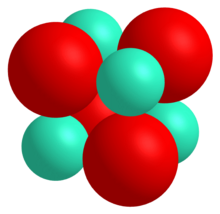Chemistry:Titanium(II) oxide

| |
| Names | |
|---|---|
| IUPAC name
Titanium(II) oxide
| |
| Other names
Titanium monoxide
| |
| Identifiers | |
3D model (JSmol)
|
|
PubChem CID
|
|
| |
| |
| Properties | |
| TiO | |
| Molar mass | 63.866 g/mol |
| Appearance | bronze crystals |
| Density | 4.95 g/cm3 |
| Melting point | 1,750 °C (3,180 °F; 2,020 K) |
| Structure | |
| cubic | |
| Hazards | |
| Flash point | Non-flammable |
| Related compounds | |
| Titanium(III) oxide Titanium(III,IV) oxide Titanium(IV) oxide | |
Except where otherwise noted, data are given for materials in their standard state (at 25 °C [77 °F], 100 kPa). | |
| Infobox references | |
Titanium(II) oxide (TiO) is an inorganic chemical compound of titanium and oxygen. It can be prepared from titanium dioxide and titanium metal at 1500 °C.[1] It is non-stoichiometric in a range TiO0.7 to TiO1.3 and this is caused by vacancies of either Ti or O in the defect rock salt structure.[1] In pure TiO 15% of both Ti and O sites are vacant,[1] as the vacancies allow metal-metal bonding between adjacent Ti centres. Careful annealing can cause ordering of the vacancies producing a monoclinic form which has 5 TiO units in the primitive cell that exhibits lower resistivity.[2] A high temperature form with titanium atoms with trigonal prismatic coordination is also known.[3] Acid solutions of TiO are stable for a short time then decompose to give hydrogen:[1]
- 2 Ti2+(aq) + 2 H+(aq) → 2 Ti3+(aq) + H2(g)
Gas-phase TiO shows strong bands in the optical spectra of cool (M-type) stars.[4][5] In 2017, TiO was claimed to be detected in an exoplanet atmosphere for the first time; a result which is still debated in the literature.[6][7] Additionally, evidence has been obtained for the presence of the diatomic molecule TiO in the interstellar medium.[8]
References
- ↑ 1.0 1.1 1.2 1.3 Holleman, Arnold Frederik; Wiberg, Egon (2001), Wiberg, Nils, ed., Inorganic Chemistry, San Diego/Berlin: Academic Press/De Gruyter, ISBN 0-12-352651-5
- ↑ Banus, M. D.; Reed, T. B.; Strauss, A. J. (1972-04-15). "Electrical and Magnetic Properties of TiO and VO". Physical Review B (American Physical Society (APS)) 5 (8): 2775–2784. doi:10.1103/physrevb.5.2775. ISSN 0556-2805. Bibcode: 1972PhRvB...5.2775B.
- ↑ Greenwood, Norman N.; Earnshaw, Alan (1997). Chemistry of the Elements (2nd ed.). Butterworth-Heinemann. ISBN 978-0-08-037941-8.
- ↑ Jorgensen, Uffe G. (April 1994). "Effects of TiO in stellar atmospheres". Astronomy and Astrophysics 284 (1): 179–186. Bibcode: 1994A&A...284..179J.
- ↑ "Spectral classification of late-type dwarfs". http://www.stsci.edu/~inr/ldwarf.html.
- ↑ Sedaghati, Elyar; Boffin, Henri M.J.; MacDonald, Ryan J.; Gandhi, Siddharth; Madhusudhan, Nikku; Gibson, Neale P.; Oshagh, Mahmoudreza; Claret, Antonio et al. (14 September 2017). "Detection of titanium oxide in the atmosphere of a hot Jupiter". Nature 549 (7671): 238–241. doi:10.1038/nature23651. PMID 28905896. Bibcode: 2017Natur.549..238S.
- ↑ Espinoza, Nestor (January 2019). "ACCESS: A featureless optical transmission spectrum for WASP-19b from Magellan/IMACS". MNRAS 482 (2): 2065–2087. doi:10.1093/mnras/sty2691. Bibcode: 2019MNRAS.482.2065E.
- ↑ Dyck, H. M.; Nordgren, Tyler E. (2002). "The Effect of TiO Absorption on Optical and Infrared Angular Diameters of Cool Stars". The Astronomical Journal (American Astronomical Society) 124 (1): 541–545. doi:10.1086/341039. ISSN 0004-6256. Bibcode: 2002AJ....124..541D.
 |

